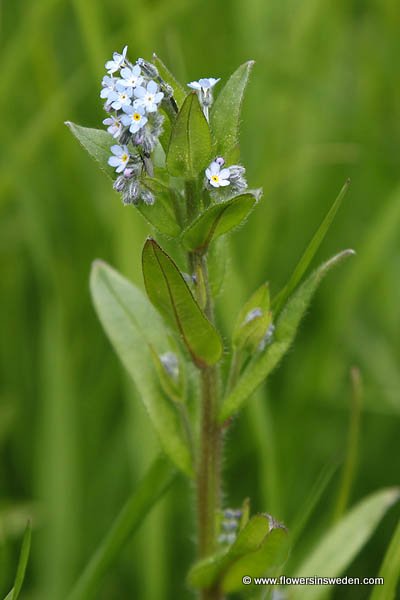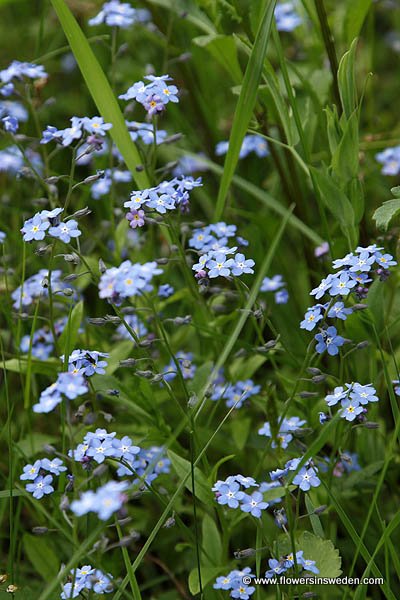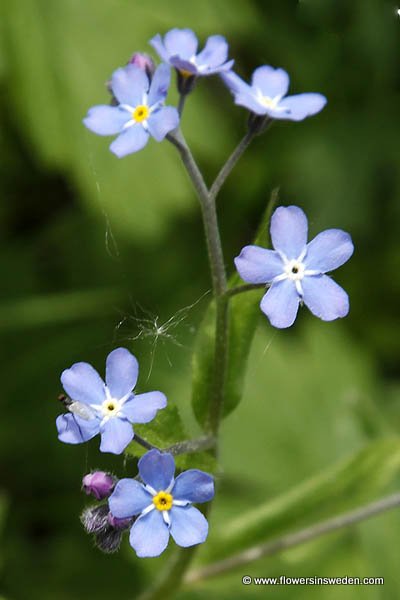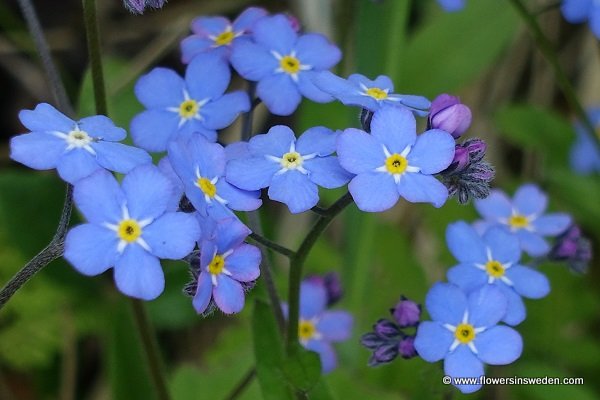|
|
| Scientific name: |
| Myosotis sylvatica Ehrh. ex Hoffm. |
| Synonym name: |
| Myosotis alpestris, Myosotis oblongata |
| Swedish name: |
| Skogsförgätmigej, trädgårdsförgätmigej |
| German name: |
| Wald-Vergissmeinnicht Bosvergeet-mij-nietje, Wood Forget-me-not |
| Nederlandse naam: |
| Bosvergeet-mij-nietje Wood |
| English name: |
| Wood Forget-me-not |
Plant Family: |
| Boraginaceae, Borage Family, Strävbladiga växter |

Location: Hammarstrand
Derivation of the botanical name:
Myosotis, Greek myos, "of a mouse", and ous, "ear". Hence it means Mouse Ear, in reference to the softly hairy, small leaves of certain European species.
sylvatica, sylva, "woods, forest", and -atic, a suffix; pertaining to; of the nature of; habitat. Growing in the woods, wild.
"Forget-me-not" was calqued from the French, "ne m'oubliez pas" and first used in English in c.1532.
- The standard author abbreviation Ehrh. is used to indicate Jakob Friedrich Ehrhart (1742 – 1795), a German botanist, a pupil of Carolus Linnaeus at Uppsala University
- The standard author abbreviation Hoffm. is used to indicate George Franz Hoffmann (1761 – 1826), a German botanist and lichenologist.
Myosotis sylvatica is Larger than Myosotis arvensis (the Field forget-me-not).
Myosotis sylvatica attracts many insects. A fly sucking honey settles for but 2-3 sec. The concealed honey is contained at the base of the ovary in the bottom of the tube, 2-3 mm. long. An insect inserts its proboscis between the stigma and anthers, which can be done from any side, so that a bee or other insect touching the anthers in one will touch the stigma in the next; and as the proboscis is withdrawn and again inserted a fly also self-pollinates it. When self-pollinated it is fertile. The plant is visited largely by bees, An-drena, and flies, Eristalis, Syritta, Rhingia, Scatophaga, Echinomyia, Onesia.
Forget-me-not symbols:
- In a German legend, God named all the plants when a tiny unnamed one cried out, "Forget-me-not, O Lord!" God replied, "That shall be your name."
- Henry IV, King of England (1366–1413), adopted the flower as his symbol during his exile in 1398 (Richard II decided to banish Henry from the kingdom (with the approval of Henry's father, John of Gaunt)), and retained the symbol upon his return to England the following year.
- In 15th-century Germany, it was supposed that the wearers of the flower would not be forgotten by their lovers. Legend has it that in medieval times, a knight and his lady were walking along the side of a river. He picked a posy of flowers, but because of the weight of his armour he fell into the river. As he was drowning he threw the posy to his loved one and shouted "Forget-me-not." It was often worn by ladies as a sign of faithfulness and enduring love.
- Rudolph Ackermann (1764-1834), an Anglo-German bookseller, inventor, lithographer, publisher and businessman, introduced the literary annual, Forget Me Not (beginning in 1823).
- Henri Rousseau (1844- 1910), a French Post-Impressionist painter in the Naive or Primitive manner. A posy of forget-me-nots in Rousseau's hand strengthens his pledge of faith.
- David Herbert Lawrence (1885-1930), English novelist, in his novel "Lady Chatterly's Lover," the Forget-Me-Not was exchanged between Lady Chatterley and her lover.
- The Forget-Me-Not has been used as a symbol of remembrance for those who have suffered or have been lost in war ; in Newfoundland, Canada, Forget-Me-Not flowers are worn on July 1 each year in memory of those who died in World War I. The Forget-Me-Not is also worn as a Masonic symbol in recognition of those who have suffered in the name of Freemasonry, particularly during the Nazi regime of World War II.
- a symbol of Alaska, as it is the state flower.
- The Forget-Me-Not flower has also been adopted as a symbol for Canada's Alzheimer Society; Alzheimer's disease is the progressive mental deterioration of the brain, hence the Forget-Me-Not symbol of memory loss.


|




